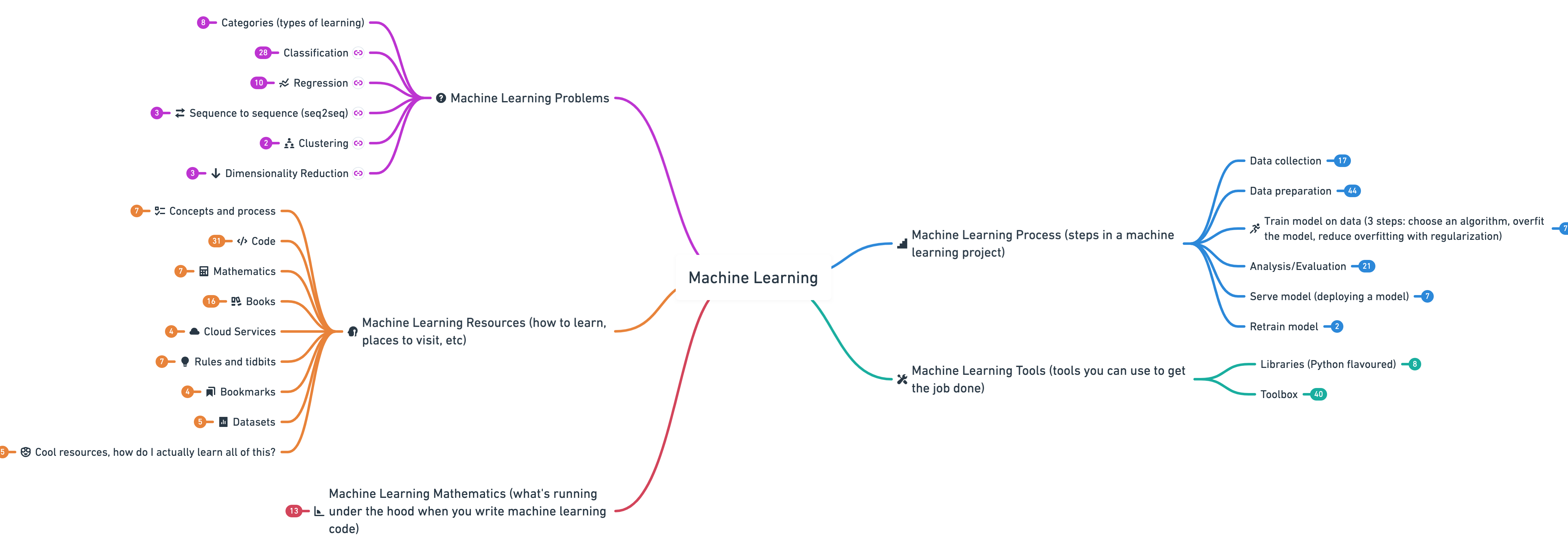 machine-learning-roadmap
machine-learning-roadmap
A roadmap connecting many of the most important concepts in machine learning, how to learn them and what tools to use to perform them.
Top Related Projects
An Open Source Machine Learning Framework for Everyone
scikit-learn: machine learning in Python
Deep Learning for humans
Tensors and Dynamic neural networks in Python with strong GPU acceleration
12 weeks, 26 lessons, 52 quizzes, classic Machine Learning for all
A series of Jupyter notebooks that walk you through the fundamentals of Machine Learning and Deep Learning in Python using Scikit-Learn, Keras and TensorFlow 2.
Quick Overview
The "machine-learning-roadmap" repository by mrdbourke is a comprehensive guide and resource collection for learning machine learning. It provides a structured path for beginners to advanced practitioners, covering various topics, tools, and techniques in the field of machine learning and artificial intelligence.
Pros
- Offers a well-organized and structured learning path for machine learning
- Includes a wide range of resources, from beginner to advanced levels
- Regularly updated with new content and resources
- Provides practical project ideas and hands-on learning opportunities
Cons
- May be overwhelming for absolute beginners due to the vast amount of information
- Some external resources linked in the roadmap may become outdated over time
- Lacks interactive elements or built-in coding exercises
- Primarily focuses on Python-based machine learning, which may not suit all learners
Getting Started
To get started with the machine-learning-roadmap:
- Visit the repository: https://github.com/mrdbourke/machine-learning-roadmap
- Read the README.md file for an overview of the roadmap
- Choose your starting point based on your current knowledge level
- Follow the suggested learning path, exploring the provided resources and projects
- Join the community discussions and contribute to the repository if you find it helpful
Competitor Comparisons
An Open Source Machine Learning Framework for Everyone
Pros of TensorFlow
- Comprehensive deep learning framework with extensive functionality
- Large community and ecosystem with many resources and pre-trained models
- Supports deployment across various platforms (mobile, web, cloud)
Cons of TensorFlow
- Steeper learning curve for beginners
- More complex setup and configuration compared to simpler libraries
- Can be overkill for basic machine learning tasks
Code Comparison
TensorFlow:
import tensorflow as tf
model = tf.keras.Sequential([
tf.keras.layers.Dense(64, activation='relu'),
tf.keras.layers.Dense(10, activation='softmax')
])
model.compile(optimizer='adam', loss='categorical_crossentropy')
Machine Learning Roadmap:
# No direct code comparison available
# The repository focuses on providing learning resources
# rather than implementation code
Summary
TensorFlow is a powerful, production-ready deep learning framework, while Machine Learning Roadmap is a curated guide for learning machine learning concepts. TensorFlow offers extensive functionality but may be complex for beginners, whereas Machine Learning Roadmap provides a structured learning path without implementation details. Choose TensorFlow for building and deploying machine learning models, and Machine Learning Roadmap for guidance on what to learn in the field of machine learning.
scikit-learn: machine learning in Python
Pros of scikit-learn
- Comprehensive library with a wide range of machine learning algorithms and tools
- Well-documented and maintained by a large community of contributors
- Seamlessly integrates with other scientific Python libraries like NumPy and Pandas
Cons of scikit-learn
- Steeper learning curve for beginners due to its extensive functionality
- Focuses on implementation rather than providing a structured learning path
- May be overwhelming for those new to machine learning concepts
Code Comparison
machine-learning-roadmap:
# No specific code implementation, primarily educational content
scikit-learn:
from sklearn.model_selection import train_test_split
from sklearn.linear_model import LogisticRegression
X_train, X_test, y_train, y_test = train_test_split(X, y, test_size=0.2)
model = LogisticRegression()
model.fit(X_train, y_train)
The machine-learning-roadmap repository is an educational resource that provides a structured learning path for machine learning concepts. It doesn't include specific code implementations but offers guidance and resources for learning.
In contrast, scikit-learn is a full-fledged machine learning library that provides ready-to-use implementations of various algorithms and tools. It's designed for practical application and integration into data science projects.
Deep Learning for humans
Pros of Keras
- Comprehensive deep learning library with extensive documentation and community support
- Offers high-level APIs for building and training neural networks quickly
- Integrates well with TensorFlow and other backend engines
Cons of Keras
- Focuses solely on deep learning, not covering broader machine learning concepts
- May be overwhelming for beginners due to its extensive features and options
- Requires additional libraries for data preprocessing and visualization
Code Comparison
Keras example:
from keras.models import Sequential
from keras.layers import Dense
model = Sequential([
Dense(64, activation='relu', input_shape=(10,)),
Dense(1, activation='sigmoid')
])
model.compile(optimizer='adam', loss='binary_crossentropy')
Machine Learning Roadmap example:
# No direct code comparison available
# The repository focuses on providing a learning roadmap
# rather than implementing machine learning algorithms
Summary
Keras is a powerful deep learning library, while the Machine Learning Roadmap is a comprehensive guide for learning machine learning concepts. Keras offers practical tools for implementing neural networks, whereas the Roadmap provides a structured learning path covering various ML topics. Choose Keras for hands-on deep learning projects, and the Roadmap for a broader understanding of machine learning concepts and career guidance.
Tensors and Dynamic neural networks in Python with strong GPU acceleration
Pros of PyTorch
- Comprehensive deep learning framework with extensive functionality
- Large, active community with frequent updates and contributions
- Robust ecosystem of tools and libraries for various ML tasks
Cons of PyTorch
- Steeper learning curve for beginners
- More complex setup and installation process
- Requires more code for basic tasks compared to high-level libraries
Code Comparison
machine-learning-roadmap:
# No specific code examples provided in the repository
PyTorch:
import torch
# Create a tensor
x = torch.tensor([1, 2, 3])
# Perform operations
y = x + 2
z = torch.matmul(x, y)
print(z)
Summary
machine-learning-roadmap is a curated guide for learning machine learning concepts, while PyTorch is a full-fledged deep learning framework. The former provides a structured learning path without code implementation, whereas PyTorch offers a complete toolkit for building and training neural networks. machine-learning-roadmap is more suitable for beginners looking to understand ML concepts, while PyTorch is ideal for practitioners who want to implement complex models and algorithms.
12 weeks, 26 lessons, 52 quizzes, classic Machine Learning for all
Pros of ML-For-Beginners
- Comprehensive curriculum with 12 weeks of lessons
- Includes hands-on projects and quizzes for practical learning
- Covers a wide range of ML topics, including classical and deep learning
Cons of ML-For-Beginners
- May be overwhelming for absolute beginners due to its breadth
- Less focus on the theoretical foundations of machine learning
- Requires more time commitment to complete the full course
Code Comparison
ML-For-Beginners:
from sklearn.model_selection import train_test_split
X_train, X_test, y_train, y_test = train_test_split(X, y, test_size=0.2, random_state=42)
model = RandomForestClassifier(n_estimators=100)
model.fit(X_train, y_train)
predictions = model.predict(X_test)
machine-learning-roadmap:
import numpy as np
import pandas as pd
from sklearn.linear_model import LogisticRegression
X = np.random.randn(100, 2)
y = np.random.randint(0, 2, 100)
model = LogisticRegression().fit(X, y)
The ML-For-Beginners repository provides a structured learning path with practical examples, while the machine-learning-roadmap offers a more concise overview of ML concepts. ML-For-Beginners is better suited for those seeking a guided, project-based learning experience, whereas machine-learning-roadmap serves as a quick reference and roadmap for ML topics.
A series of Jupyter notebooks that walk you through the fundamentals of Machine Learning and Deep Learning in Python using Scikit-Learn, Keras and TensorFlow 2.
Pros of handson-ml2
- Comprehensive coverage of machine learning concepts with practical examples
- Jupyter notebooks for interactive learning and experimentation
- Regular updates to keep content current with latest ML trends
Cons of handson-ml2
- May be overwhelming for absolute beginners due to its depth
- Focuses primarily on scikit-learn and TensorFlow, potentially limiting exposure to other libraries
Code Comparison
handson-ml2:
from sklearn.ensemble import RandomForestClassifier
forest_clf = RandomForestClassifier(n_estimators=100, random_state=42)
forest_clf.fit(X_train, y_train)
y_pred = forest_clf.predict(X_test)
machine-learning-roadmap:
# No specific code examples provided in the repository
# The roadmap focuses on conceptual understanding and learning resources
The machine-learning-roadmap repository is more of a guide and resource collection, while handson-ml2 provides hands-on coding examples and exercises. The roadmap offers a structured learning path for beginners, whereas handson-ml2 dives deeper into practical implementation. Both repositories complement each other, with the roadmap providing direction and handson-ml2 offering in-depth practical knowledge.
Convert  designs to code with AI
designs to code with AI

Introducing Visual Copilot: A new AI model to turn Figma designs to high quality code using your components.
Try Visual CopilotREADME
2020 Machine Learning Roadmap (still 90% valid for 2023)

A roadmap connecting many of the most important concepts in machine learning, how to learn them and what tools to use to perform them.
Namely:
- ð¤ Machine Learning Problems - what does a machine learning problem look like?
- â»ï¸ Machine Learning Process - once youâve found a problem, what steps might you take to solve it?
- ð Machine Learning Tools - what should you use to build your solution?
- 𧮠Machine Learning Mathematics - what exactly is happening under the hood of all the machine learning code you're writing?
- ð Machine Learning Resources - okay, this is cool, how can I learn all of this?
See the full interactive version.
Watch a feature-length film video walkthrough (yes, really, it's longer than most movies).
Many of the materials in this roadmap were inspired by Daniel Formoso's machine learning mindmaps,so if you enjoyed this one, go and check out his. He also has a mindmap specifically for deep learning too.
Top Related Projects
An Open Source Machine Learning Framework for Everyone
scikit-learn: machine learning in Python
Deep Learning for humans
Tensors and Dynamic neural networks in Python with strong GPU acceleration
12 weeks, 26 lessons, 52 quizzes, classic Machine Learning for all
A series of Jupyter notebooks that walk you through the fundamentals of Machine Learning and Deep Learning in Python using Scikit-Learn, Keras and TensorFlow 2.
Convert  designs to code with AI
designs to code with AI

Introducing Visual Copilot: A new AI model to turn Figma designs to high quality code using your components.
Try Visual Copilot